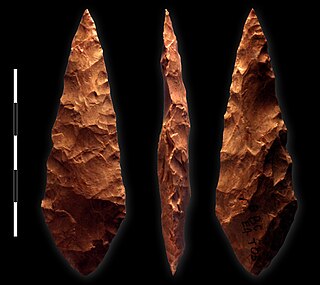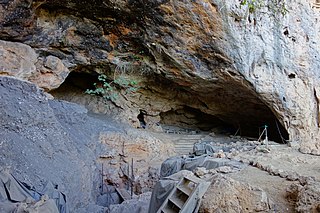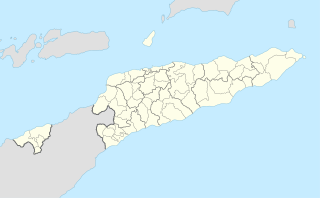
Africa has the longest record of human habitation in the world. The first hominins emerged 6-7 million years ago, and among the earliest anatomically modern human skulls found so far were discovered at Omo Kibish, Jebel Irhoud, and Florisbad.

The Aterian is a Middle Stone Age stone tool industry centered in North Africa, but also possibly found in Oman, the Thar Desert, Sahara and northeast Africa. The earliest Aterian dates to c. 150,000 years ago, at the site of Ifri n'Ammar in Morocco. However, most of the early dates cluster around the beginning of the Last Interglacial, around 150,000 to 130,000 years ago, when the environment of North Africa began to ameliorate. The Aterian disappeared around 20,000 years ago.

The Middle Stone Age was a period of African prehistory between the Early Stone Age and the Later Stone Age. It is generally considered to have begun around 280,000 years ago and ended around 50–25,000 years ago. The beginnings of particular MSA stone tools have their origins as far back as 550–500,000 years ago and as such some researchers consider this to be the beginnings of the MSA. The MSA is often mistakenly understood to be synonymous with the Middle Paleolithic of Europe, especially due to their roughly contemporaneous time span, however, the Middle Paleolithic of Europe represents an entirely different hominin population, Homo neanderthalensis, than the MSA of Africa, which did not have Neanderthal populations. Additionally, current archaeological research in Africa has yielded much evidence to suggest that modern human behavior and cognition was beginning to develop much earlier in Africa during the MSA than it was in Europe during the Middle Paleolithic. The MSA is associated with both anatomically modern humans as well as archaic Homo sapiens, sometimes referred to as Homo helmei. Early physical evidence comes from the Gademotta Formation in Ethiopia, the Kapthurin Formation in Kenya and Kathu Pan in South Africa.

The Quaternary period has seen the extinctions of numerous predominantly megafaunal species, which have resulted in a collapse in faunal density and diversity and the extinction of key ecological strata across the globe. The most prominent event in the Late Pleistocene is differentiated from previous Quaternary pulse extinctions by the widespread absence of ecological succession to replace these extinct species, and the regime shift of previously established faunal relationships and habitats as a consequence.

Benzú is a small settlement within the Spanish autonomous city of Ceuta. It has a population of 1,987 according to the 2011 census, divided into two units with Ceuta as its municipality.

Wonderwerk Cave is an archaeological site, formed originally as an ancient solution cavity in dolomite rocks of the Kuruman Hills, situated between Danielskuil and Kuruman in the Northern Cape Province, South Africa. It is a National Heritage Site, managed as a satellite of the McGregor Museum in Kimberley. Geologically, hillside erosion exposed the northern end of the cavity, which extends horizontally for about 140 m (460 ft) into the base of a hill. Accumulated deposits inside the cave, up to 7 m (23 ft) in-depth, reflect natural sedimentation processes such as water and wind deposition as well as the activities of animals, birds, and human ancestors over some 2 million years. The site has been studied and excavated by archaeologists since the 1940s and research here generates important insights into human history in the subcontinent of Southern Africa. Evidence within Wonderwerk cave has been called the oldest controlled fire. Wonderwerk means "miracle" in the Afrikaans language.

Qesem cave is a Lower Paleolithic archeological site near the city of Kafr Qasim in Israel. Early humans were occupying the site by 400,000 until c. 200,000 years ago.

Mechta-Afalou (Mechtoid) or Paleo-Berber are a population that inhabited parts of North Africa during the late Paleolithic and Mesolithic. They are associated with the Iberomaurusian archaeological culture.

The Iberomaurusian is a backed bladelet lithic industry found near the coasts of Morocco, Algeria, and Tunisia. It is also known from a single major site in Libya, the Haua Fteah, where the industry is locally known as the Eastern Oranian. The Iberomaurusian seems to have appeared around the time of the Last Glacial Maximum (LGM), somewhere between c. 25,000 and 23,000 cal BP. It would have lasted until the early Holocene c. 11,000 cal BP.

Howieson's Poort Shelter is a small rock shelter in South Africa containing the archaeological site from which the Howiesons Poort period in the Middle Stone Age gets its name. This period lasted around 5,000 years, between roughly 65,800 BP and 59,500 BP. This period is important as it, together with the Stillbay period 7,000 years earlier, provides the first evidence of human symbolism and technological skills that were later to appear in the Upper Paleolithic.

Diepkloof Rock Shelter is a rock shelter in Western Cape, South Africa in which has been found some of the earliest evidence of the human use of symbols, in the form of patterns engraved upon ostrich eggshell water containers. These date around 60,000 years ago.

Nassarius gibbosulus, common name the swollen nassa, is a species of sea snail, a marine gastropod mollusk in the family Nassariidae, the Nassa mud snails or dog whelks.

Neanderthals are an extinct species or subspecies of archaic humans who lived in Eurasia until about 40,000 years ago. They most likely went extinct due to great climatic change, disease, or a combination of these factors. They were fully replaced by early European modern humans.

Taforalt or Grotte des Pigeons is a cave in the province of Berkane, Béni Iznasen region, Morocco, possibly the oldest cemetery in North Africa. It contained at least 34 Iberomaurusian adolescent and adult human skeletons, as well as younger ones, from the Upper Palaeolithic between 15,100 and 14,000 calendar years ago. There is archaeological evidence for Iberomaurusian occupation at the site between 23,200 and 12,600 calendar years ago, as well as evidence for Aterian occupation as old as 85,000 years.

Theopetra Cave is located in Thessaly, Greece, on the north-east side of a limestone rock formation, 3 km (2 mi) south of Kalambaka. The site has become increasingly important as human presence is attributed to all periods of the Middle and Upper Paleolithic, the Mesolithic, Neolithic and beyond, bridging the Pleistocene with the Holocene.
Kehf el Baroud, sometimes mistakenly spelled Kelif el Boroud, is an archaeological site in Morocco. It is located to the south of Rabat, near Dar es Soltan.

Jerimalai is a limestone cave southeast of Tutuala, on the eastern tip of East Timor. Fish remains and fish hooks excavated in Jerimalai provide evidence for advanced fishing technique by inhabitants of Timor 42,000 years ago.

















